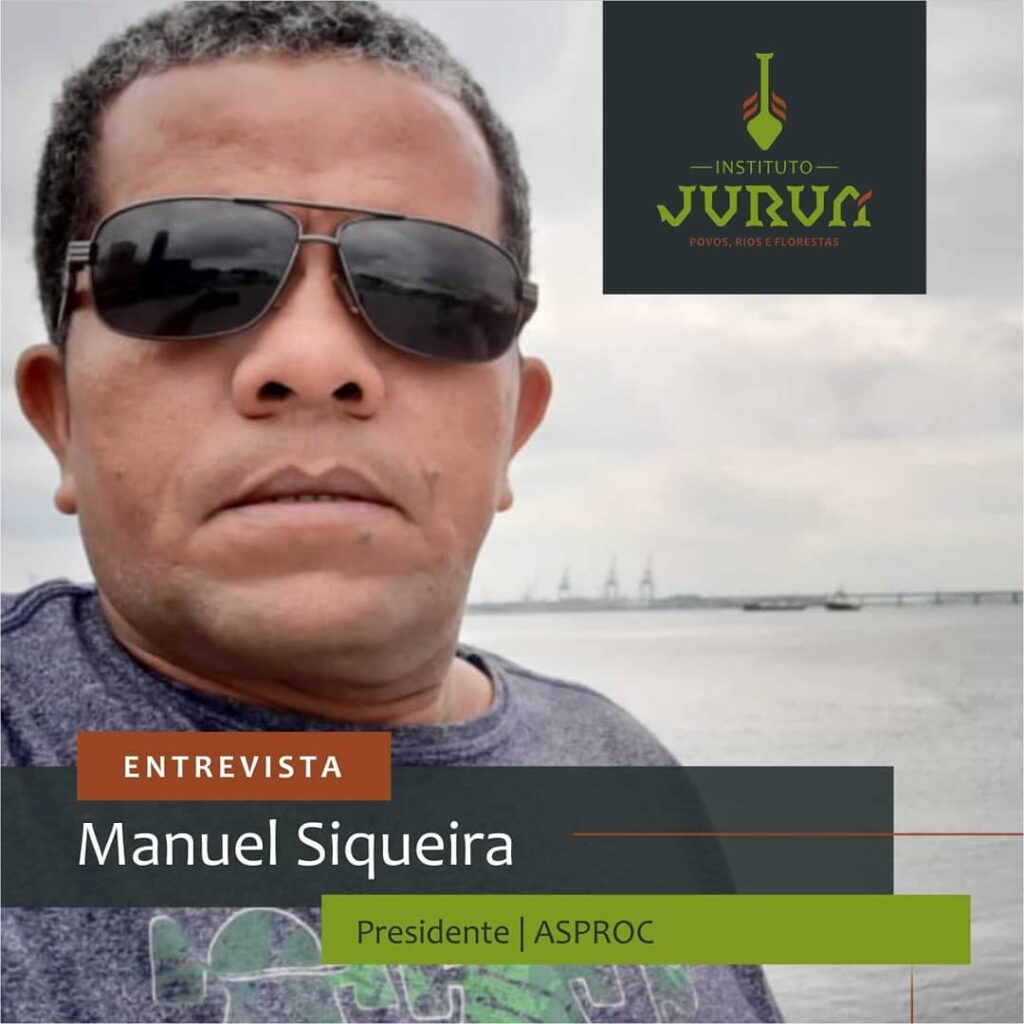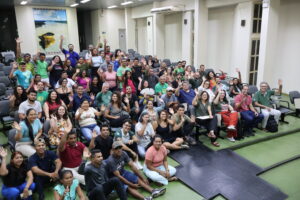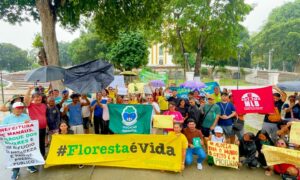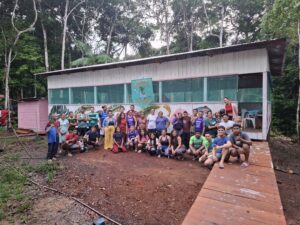By Clara Machado
ASPROC (Associação de Produtores Rurais de Carauari) was the first organization created in the middle Juruá. With 27 years of experience, it operates in the organization and commercialization of rural production from the region’s agrextractivist communities, in addition to the fundamental role of the struggle for territory and the creation of conservation units. Through collective work, ASPROC abolished intermediary trading boats that previously exploited commercial exchanges of agroextractivism products in the middle Juruá, and facilitated the conversation between land agencies and traditional populations, introducing a new degree of access to the Brazilian agrarian reform credit system for housing improvements. Creator of a sanitation project that became a federal public policy, ASPROC also contributed to standardising the price paid for the pirarucu managed by grassroots associations across the state of Amazonas through the creation of the Pirarucu Collective (“Coletivo do Pirarucu”).

To tell us more about the history and work of ASPROC, we invited Manuel Siqueira, known as Manuelzinho, president of the association for the third time and important local leader whose history of engagement and optimism inspires the association which, in his words, is the “mother organization” of the middle Juruá region.
INSTITUTO JURUÁ. Could you, please, introduce yourself and tell us what ASPROC is?
MANUELZINHO. I am Manuel Cosme Siqueira, known as Manuelzinho, current president of the Association of Rural Producers of Carauari, ASPROC. ASPROC is the mother organization of the middle Juruá, it was the first association created in the region, and it was born with the objective of organizing and commercializing the production of rural communities and seeking the rights of its associates. I am in my third term and throughout this time, we always seek partnerships to carry out activities within the communities of the association. We are very conscious about the advances already made in the middle Juruá. These achievements are also due to partners who work together here in the region with grassroots organizations. This work, result of partnerships and union, has enabled positive results in what we have always defended – the improvement of the quality of life of families and the conservation of natural resources – so that future generations have even better development opportunities. These are the objectives of ASPROC, as well as that of the other partners who work here.
INSTITUTO JURUÁ. Considering the long distances that separate rural communities, and the difficulties in access, especially in the early 1990s when ASPROC was established, how did the population manage to organize themselves to create this producers’ association?
MANUELZINHO. Before the association, the middle Juruá region was organized in rubber plantations (seringais), where the rubber barons dominated, oppressed, considered themselves the owners of the land, and the rubber tappers worked for them. At the end of the 1980s, a movement led by MEB (Basic Ecclesiastical Movement) of the Catholic Church began, with Father João Derickx, who began the work of mobilizing workers, rubber tappers at the time, in order to understand their rights. After several meetings debating the way of life at the time, they began to understand the importance of organizing themselves in communities. In the beginning there were few, four or five communities that started to mobilize to get out of that oppressive system of persecution and seek other opportunities. At that time, there were many threats. Leaders were arrested to stop us from escaping that system. Then, we started to organize ourselves to sell our produce. Some leaders traveled to the nearby cities, sold the products and returned with basic hampers of essentials for their communities, bought with the sale of their produce. This movement encouraged other communities to get involved in this initiative, perceiving the advantages in prices, since the products were sold at much better prices than they were used to. From then on, we understood that it was not enough just to create communities, but it was also important to create an organization that represented us, and that was when ASPROC emerged. ASPROC was created legally in 1994 but since 1990 it has already been working informally, articulating the community’s interests. With the organization of the communities and commercialization of production, many advances emerged, until we realized the importance of guaranteeing the territory and started to fight for the establishment of conservation units (reserves). We recognize, in the middle Juruá, our history of struggle, of great difficulty, but when we look back we see that it was worth it. We used to say that at that time we could never imagine the advances we managed to achieve. The more you advance, you conquer, you improve your life, the more you believe, and we can’t stop. Every day we reach a little more.
INSTITUTO JURUÁ. What is the relation between ASPROC and the creation of the Middle Juruá Extractive Reserve (RESEX Médio Juruá) and the Uacari Sustainable Development Reserve (RDS Uacari)?
MANUELZINHO. Things happened step by step. First it was this process of organizing ourselves in communities to seek our rights. The second step was to create an association to represent us and the other step was the struggle for the territory, because we could only move forward if we could guarantee our territory. When it was created, ASPROC also had this objective of fighting for territory. So ASPROC was very important in this process. I would say that there would be no RESEX if we had not created ASPROC before. The RESEX was created in 1997 and ASPROC continued to act in the process of organization and social mobilization, giving all its support for the implementation of the RDS Uacari, in recognition of the communities that had been left out of the RESEX, and together we guaranteed 100% of this territory for these rural communities. So, ASPROC was very important for achieving this mobilization, searching, formulating and overcoming conflicts, so that we could reach our goal of creating the Uacari RDS.
INSTITUTO JURUÁ. There are many projects ahead of ASPROC, many initiatives, activities and partnerships, but there are two main fronts: social projects and projects aimed at marketing production and income generation. Within these two fronts, the social and the productive front, what were the major milestones in the history of the association?
MANUELZINHO. ASPROC always seeks improvement, so we created our strategic planning within the association to better plan our actions. This planning is defined by axes: we have the axis of social actions, and the axis of income generation, among others. In terms of social actions, we consider the integration of the National Agrarian Reform Programme to be a very important milestone, which we have managed, through formulation with supporters and partners, to implement. And we have made a very big leap in the quality of families’ housing, that until then often had very unsuitable foundation stilts. And today we can see this in practice, with about 90% of the households in the two reserves under this policy. In addition, the implementation of sanitation was another major milestone. ASPROC, supported by Petrobras, started a sanitation system with a pilot project in a single rural community, implementing the pumping, treatment and distribution of water to supply families. We managed to continue this project by creating the Sanear Amazônia Program, which became a nationwide public policy of the Brazilian federal government. Thanks to this initiative, with a project in just one community, a few years later we were able to implement it across the municipality of Carauari and this sanitation policy was then replicated in other places across Brazil, improving the quality of life for many families. In terms of income generation, we have developed commercialization through public policies such as the PAA (Programa de Aquisição de Alimentos – Food Acquisition Programme) and PNAE (Programa Nacional de Alimentação Escolar – National School Meals Programme). We have the plant oil production chain, which is super important, we have the family agriculture chain, the production of latex from the rubber tree that is returning to force, and also the management of pirarucu fisheries, which is the newest production chain, started in 2010. This management initiative generates a very important income for the communities, and behind the management there is the entire history of community organization, protection of the lakes and all the chains and benefits brought by the various activities involved. All these achievements, such as the management of pirarucu and the resumption of the rubber production chain at fair prices, are the results of organization and partnerships, and represent examples of sustainable activities that generate income and improve the environment as a whole.
INSTITUTO JURUÁ. Comércio Ribeirinho da Cidadania e Solidário is another important project within ASPROC, in which the production of the communities is commercialized and, at the same time, industrialized products are traded at fair prices within the communities. How was the implementation of this project?
MANUELZINHO. ASPROC always worked to organize and commercialize rural production, and we tried several marketing models. We started with our boat transporting the production, but we soon realized that other models would be more interesting. Then, in 2009, we created the “Comércio Ribeirinho da Cidadania e Solidário”, which installed marketing hubs in the communities themselves, grouping nearby communities. We consider this one of ASPROC’s most important projects, because it guarantees the commercialization of the communities’ production. The big challenge was how to trade, we already produced on a large scale but we had difficulties in commercializing our produce. In addition to offering essential household items at a fair price, our marketing hubs also made it possible to trade the production of the communities. Comércio Ribeirinho works in all areas that ASPROC works in, it is an umbrella project wherever there are other ASPROC projects related to commercialization, such as the management of pirarucu and the production of rubber. It was a great achievement for the association and nowadays it is well established There are annual meetings where we assemble, debate and carry out strategic planning for the year, as well as decide the main community demands that we will seek to support. We always work with community assemblies, where our priorities for the year come from, and then the board of directors, team of advisors and partners pursue the matters discussed. I believe that this is what makes it possible to give a voice to the collective, which is very positive.
INSTITUTO JURUÁ. How has ASPROC been winning partnerships?
MANUELZINHO. We have our board meetings as a quarterly practice where we always base our efforts, our weaknesses, our challenges and how to overcome them, and we know that not all challenges we will be able to overcome alone. From this experience of surveying the challenges, we identify possible partners and from there we seek their support to overcome challenges together. We always work collectively, joining forces. We have partners here in the region, including institutions in the private sector as well, such as Natura and Coca-Cola. There came a time when we realized that we had several partners but that we didn’t work collectively on the planning as a whole. That was when we got together and created the ‘Forum do Território Médio Juruá’, calling all organizations and entities that worked here in the region so that we could debate, share planning and aggregate activities that had the same objectives, reducing costs and gaining efficiency. This collective, honest, transparent and well-done job attracted a large number of very important partners here in the middle Juruá, ever increasing our work together with the communities.
INSTITUTO JURUÁ. How did ASPROC become a reference in the management of pirarucu in the state of Amazonas, with the construction of the Coletivo do Pirarucu?
MANUELZINHO. There was much discussion about the price of pirarucu. In some places the minimum price was paid and here in the middle Juruá we were able to negotiate up to twice the price practiced in the state as a whole. As a result, ASPROC was invited to participate, and we mobilized to create the Pirarucu Collective (“Coletivo do Pirarucu”), which includes basically all the associations that work with the management of pirarucu fisheries across the state of Amazonas, so that we could discuss how to improve the price in these other areas. As such, ASPROC has become a reference in commercialization and we have managed to standardise prices in the middle Juruá for these other areas as well. We always focus on transparency, laying clearly on the table how much is spent, how the product is being sold, and how much is returning so that we can, in every way, improve and return more value to those who actually do the hard work – those who conduct the management and protection, i.e. the communities themselves who directly manage the fisheries. With this financial control and cost reduction that we have from our management and administration, we will be able to further improve this price paid to them.
INSTITUTO JURUÁ. How can ASPROC expand, grow and reach other regions dealing with all challenges, such as internet access in the region, without losing close contact with rural communities?
MANUELZINHO. We really have enormous challenges, but in more than 25 years on the road, we have already learned many lessons and overcome many difficulties. Yes, we have difficulties with internet, communication and even physical access. One of the strategic solutions was to create a focal point in Manaus to minimize the internet and communication problems, as for the market, since the municipality of Carauari is very isolated. We have managed to improve our communication with the communities via radio and four years ago we were also able to bring the internet to some communities. The internet here in urban areas of the municipality has also improved, but it is still not enough. With regards to ASPROC working so well, what we consider very important is our identification with the community base. It is the base that must be organized and strengthened to bring forward demands. The board of directors is responsible, transparent and dedicated to seek solutions to the demands of the communities and also have partners who can advance this search for improvements. The secret of ASPROC is to always prioritize the demands of the communities, to maintain transparency in the execution of its activities, and to seek partners who really identify with their cause and who have the same objectives. These values generate solutions – this is the biggest lesson we have learnt at ASPROC.
INSTITUTO JURUÁ. What are the challenges that ASPROC has been facing lately, especially this year, with the pandemic and the commercial shutdowns?
MANUELZINHO. This was a very unusual year. The pandemic hindered some contracts, but we still need to ensure that we sell our produce. We always try not to depend exclusively on one trade – we always have other trades so that we can adapt ourselves to overcome difficult periods and enable the continuity of the communities’ work. Our main challenge is still that of commercialization, since the costs are still very high due to the distances that we have here. The resources available for public policies, such as PAA and PNAE which were support programs for our production, have been drastically reduced and, therefore, our sales to the State for school meals and social programs has been compromised. These are some difficulties, but they also enable us to learn and search for new opportunities. After all, public policies, no matter how important and beneficial for workers they are, they can simply end, and we cannot end with them.
INSTITUTO JURUÁ. What are the prospects for ASPROC for the coming years?
MANUELZINHO. At our warehouse in Carauari, we intend to expand to other areas that we are still unable to reach. We want to build collective planning to reach a much larger area than we currently operate. Another ambition of ours is to work with the management of other forest species with great potential, in addition to pirarucu, so that we can maintain our objective and keep our sectors functioning throughout the year, and thus increase opportunities for income generation. These are our goals for the future.






